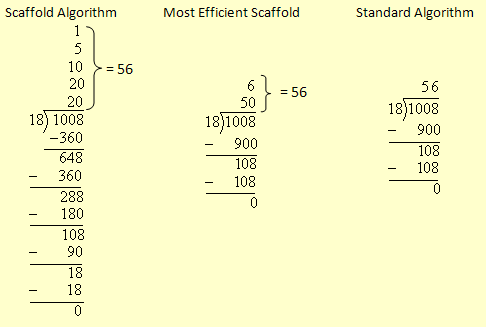Readings for Session 11 – (Continued)
Algorithms for Division of Whole
Numbers
Division requires a good understanding of place value, because the standard algorithm for division is based on place values.
Compare these related multiplication and division problems:
|
2 × 4 = 8 and |
|
|
|
2 × 40 = 80 and |
|
|
|
2 × 400 = 800 and |
|
|
If we are careful about how we line up the digits in the quotient with the digits in the dividend, we see how the three division problems are related.
When we do the division for each of the above three problems, we often say that “2 goes into 8 four times” and place the 4 above the 8. The zeros are added to indicate the proper place-value of the 4. We illustrate this with the money model for each of the problems, which show that we are forming two sets of bills and answering the question: “How many elements are in each set?”
Scaffold Algorithm for Division
Example: May and Jay’s are to share an inheritance of $860. How much should each receive? To solve the problem, we want to divide 860 by 2.
|
|
First, we begin by dividing 8 hundred by 2,
which gives us 4 hundred. Since we have used 8 hundred, we subtract 860 |
|
|
|
|
Next, we share the $60. Since 2 × 30 = 60, we need to add another
30 to our quotient. Notice we place
the 30 in the proper place value above the 400. We have also subtracted 60 |
|
|
|
|
The last step is to sum the two partial
quotients to obtain the final quotient.
This method of division is called the scaffold algorithm for
long division. |
|
Here are two different examples that use the scaffold algorithm to divide 976 by 2. The first example uses the most efficient partial quotients. The second example uses more partial quotients but they are in smaller pieces; this is like passing out a large number of items by giving each person a few at a time. Since we may pass out any number of items at a time, the number of partial quotients we use does not matter. We do need to pay attention to the place values.
Many students, who find the standard algorithm for long-division difficult, find
the scaffold method helpful, especially when they use “comfortable chunks”
instead of always looking for the most efficient partial quotient. If long
division is difficult for you, try using the scaffold method.
![]()
Return
to Peil's Homepage | Minnesota
State University Moorhead | Mathematics
Department

